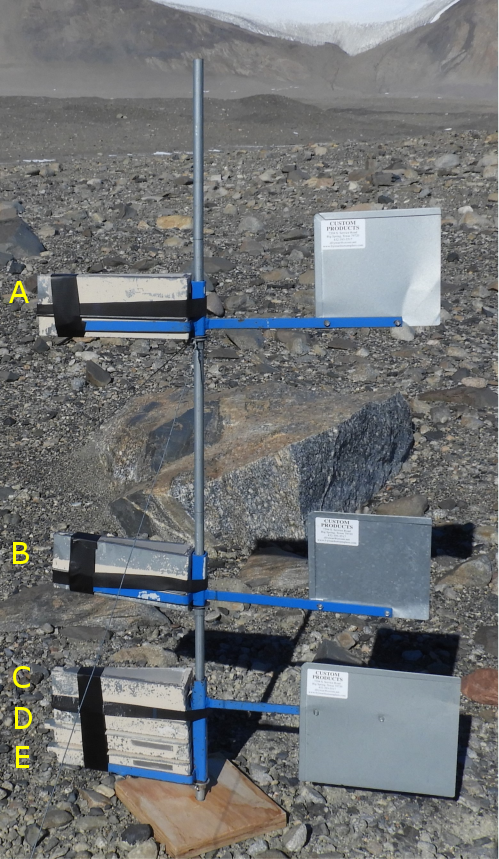Research area #4: Aeolian processes
Antarctic aeolian materials
Aeolian (wind-derived) processes play an important role in the global transport of both geological and biological materials that, in turn, can greatly impact the biogeochemistry of terrestrial and aquatic ecosystems. Arid regions, particularly polar and alpine desert environments, have diminished landscape connectivity compared to temperate regions due to limited and/or seasonal hydrological processes. For these environments, aeolian processes play a particularly important role in landscape evolution and biotic community vitality through nutrient and solute additions.

Big Spring Number Eight (BSNE) collector in the McMurdo Dry Valleys
The McMurdo Dry Valleys (MDV) are the largest ice-free area in Antarctica and are potentially a major source of aeolian material for the continent. We evaluated the role of drainage, foehn, and coastal winds in transporting nutrients. We collected aeolian materials near the surface and ~100 cm above the surface and found:
- Material in Taylor Valley was generally transported down valley from Taylor Glacier toward the coast. Summer up-valley winds are weaker and did not transport significant material far inland.
- Nitrate rich material originating from the higher-elevation, inland locations may help to support younger N-limited soils, while lower elevations could be source of phosphorus for older P-limited soils during times of high particle transport.
- Lower collection height samples demonstrated little intervalley connectivity, while the uppermost samples demonstrated some mixing, altering the chemical continuum.

McMurdo Dry Valleys, Antarctica
In the Southern Hemisphere, the major sources of dust and other aeolian materials are from Patagonia, South Africa, Australia, and New Zealand. However, little information exists on modern Antarctic dust sources, transport, and its role in the Southern Hemisphere dust cycle. We evaluated the trace and rare earth element geochemistry and mineralogy of materials from the McMurdo Dry Valleys.
We found that low elevation and coastal locations (with respect to the Ross Sea) are dominated by local sources, but high elevation and inland locations may have accumulated both local materials and dust from other distant Southern Hemisphere sources. By geochemically “fingerprinting” aeolian materials from the Dry Valleys, we can better inform future studies on the transport of materials within Antarctica and between Southern Hemisphere land masses.
Mid-latitude dust
The long-range transport of Saharan dust to South America, the Caribbean Basin, and even the southern United States has been demonstrated by both remotely sensed satellite data and direct measurements. Saharan dust is possibly an important source of phosphorus to old, weathered landscapes that are P-limited.

Flux of Saharan dust to Panama
We used a Cloud-Aerosol Lidar with Orthogonal Polarization (CALIOP) model to calculate dust deposition rates to Panama. Phosphorus deposition ranged from 35 to 122 g P ha-1 yr-1, with the greatest deposition occurring in the spring and early summer months. Though much of the dust-deposited P is likely rapidly taken up and recycled by vegetation, continual inputs of Ca, Mg, and K could significantly aid in long term rainforest productivity.
Partners/Collaborators
This research was conducted with the McMurdo Long Term Ecological Research network.
Research Papers
- Geochemistry of Aeolian Material from the McMurdo Dry Valleys, Antarctica: Insights into Dust Sources. doi.org/10.1016/j.epsl.2020.116460
- Aeolian Material Transport and its Role in Landscape Connectivity in the McMurdo Dry Valleys, Antarctica. https://doi.org/10.1029/2017JF004589
- Major Oxide Chemistry of Mineral Dust, McMurdo Dry Valleys, Antarctica: Revisited. DOI:10.14644/dust.2018.005
- The Flux of Saharan Dust to Panama and its Influence on Soil Geochemistry. DOI:10.14644/dust.2016.006
